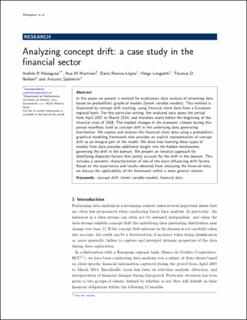| dc.contributor.author | Masegosa, Andres | |
| dc.contributor.author | Martinez, Ana M. | |
| dc.contributor.author | Ramos-López, Dario | |
| dc.contributor.author | Langseth, Helge | |
| dc.contributor.author | Nielsen, Thomas D. | |
| dc.contributor.author | Salmeron, Antonio | |
| dc.date.accessioned | 2021-03-25T14:19:22Z | |
| dc.date.available | 2021-03-25T14:19:22Z | |
| dc.date.created | 2020-11-04T10:23:49Z | |
| dc.date.issued | 2020 | |
| dc.identifier.citation | Intelligent Data Analysis. 2020, 24 (3), 665-688. | en_US |
| dc.identifier.issn | 1088-467X | |
| dc.identifier.uri | https://hdl.handle.net/11250/2735575 | |
| dc.description.abstract | In this paper, we present a method for exploratory data analysis of streaming data based on probabilistic graphical models (latent variable models). This method is illustrated by concept drift tracking, using financial client data from a European regional bank. For this particular setting, the analyzed data spans the period from April 2007 to March 2014 and therefore starts before the beginning of the financial crisis of 2008. The implied changes in the economic climate during this period manifests itself as concept drift in the underlying data generating distribution. We explore and analyze this financial client data using a probabilistic graphical modeling framework that provides an explicit representation of concept drift as an integral part of the model. We show how learning these types of models from data provides additional insight into the hidden mechanisms governing the drift in the domain. We present an iterative approach for identifying disparate factors that jointly account for the drift in the domain. This includes a semantic characterization of one of the main influencing drift factors. Based on the experiences and results obtained from analyzing the financial data, we discuss the applicability of the framework within a more general context. | en_US |
| dc.language.iso | eng | en_US |
| dc.publisher | IOS Press | en_US |
| dc.subject | Concept drift, latent variable models, financial data | en_US |
| dc.title | Analyzing concept drift: A case study in the financial sector | en_US |
| dc.type | Journal article | en_US |
| dc.type | Peer reviewed | en_US |
| dc.description.version | acceptedVersion | en_US |
| dc.source.pagenumber | 665-688 | en_US |
| dc.source.volume | 24 | en_US |
| dc.source.journal | Intelligent Data Analysis | en_US |
| dc.source.issue | 3 | en_US |
| dc.identifier.doi | 10.3233/IDA-194515 | |
| dc.identifier.cristin | 1844797 | |
| cristin.ispublished | true | |
| cristin.fulltext | preprint | |
| cristin.qualitycode | 1 | |
